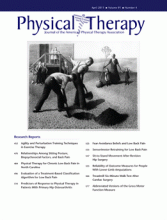Abstract
Background Although fear-avoidance beliefs (FABs) have been explored in younger adults and Spanish older adults, their relationships to measures of low back pain (LBP)–related disability, overall physical health, and falling have not been investigated in older American adults.
Objective The purpose of this study was to examine the association of FABs with self-reported disability, physical health, and falling among community-dwelling older adults with LBP in the United States.
Design This was a cross-sectional study.
Methods Ninety-three community-dwelling men and women with current LBP were included in this analysis. Participants completed the Fear-Avoidance Beliefs Questionnaire physical activity subscale (FABQ-PA). The modified Oswestry Disability Questionnaire (mOSW) and the Quebec Back Pain Disability Scale (QUE) were used to measure self-reported disability, and the Medical Outcomes Study 36-Item Short-Form Health Survey questionnaire (SF-36) physical component summary (PCS) score was used to assess physical health. Participants provided demographic information and information regarding LBP duration and intensity. Linear regression models were developed using the following dependent variables: mOSW, QUE, and SF-36 PCS scores. Logistic regression was used to determine the association between high FABs and falling.
Results For each analysis, the FABQ-PA score independently explained 3% to 6% of the variance in the LBP-related disability score and 3% of the variance in the SF-36 PCS score. For all dependent variables, the strongest contributors to explained variance were pain intensity, assistive device use, and FABQ-PA score. High FABs were associated with falling.
Limitations Future investigations might seek a more diversified sample and utilize both qualitative and quantitative measures for assessing disability and physical health.
Conclusions Physical activity FABs are independently associated with self-reported disability and overall physical health in older American adults with LBP. High FABs may warrant balance and falls assessment.
Footnotes
Both authors provided concept/idea/research design, writing, data analysis, and consultation (including review of manuscript before submission). Dr Hicks provided data collection, project management, and fund procurement.
A platform presentation of this research was given at the Combined Sections Meeting of the American Physical Therapy Association; February 17–20, 2010; San Diego, California. A poster presentation of this research was made at the Exercise and Physical Activity in Aging Conference: Blending Research and Practice (ExPAAC); July 29–31, 2010; Indianapolis, Indiana.
Data collection was funded by the Intramural Research Program of the National Institute on Aging, National Institutes of Health. Preparation of the manuscript by Dr Sions and Dr Hicks was supported by R21 HD057274 (Eunice Kennedy Shriver National Institute of Child Health and Human Development). The work of Dr Hicks, a CORRT scholar, also was supported by 1K12HD055931-01 (Eunice Kennedy Shriver National Institute of Child Health and Human Development).
- Received April 14, 2010.
- Accepted December 21, 2010.












